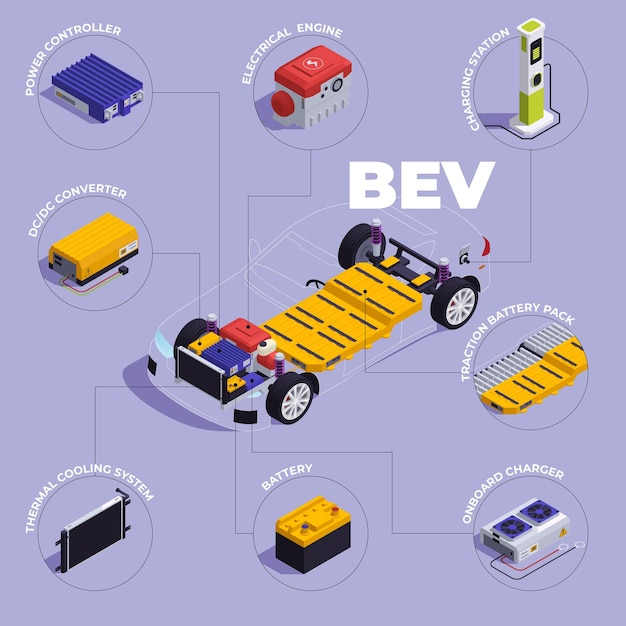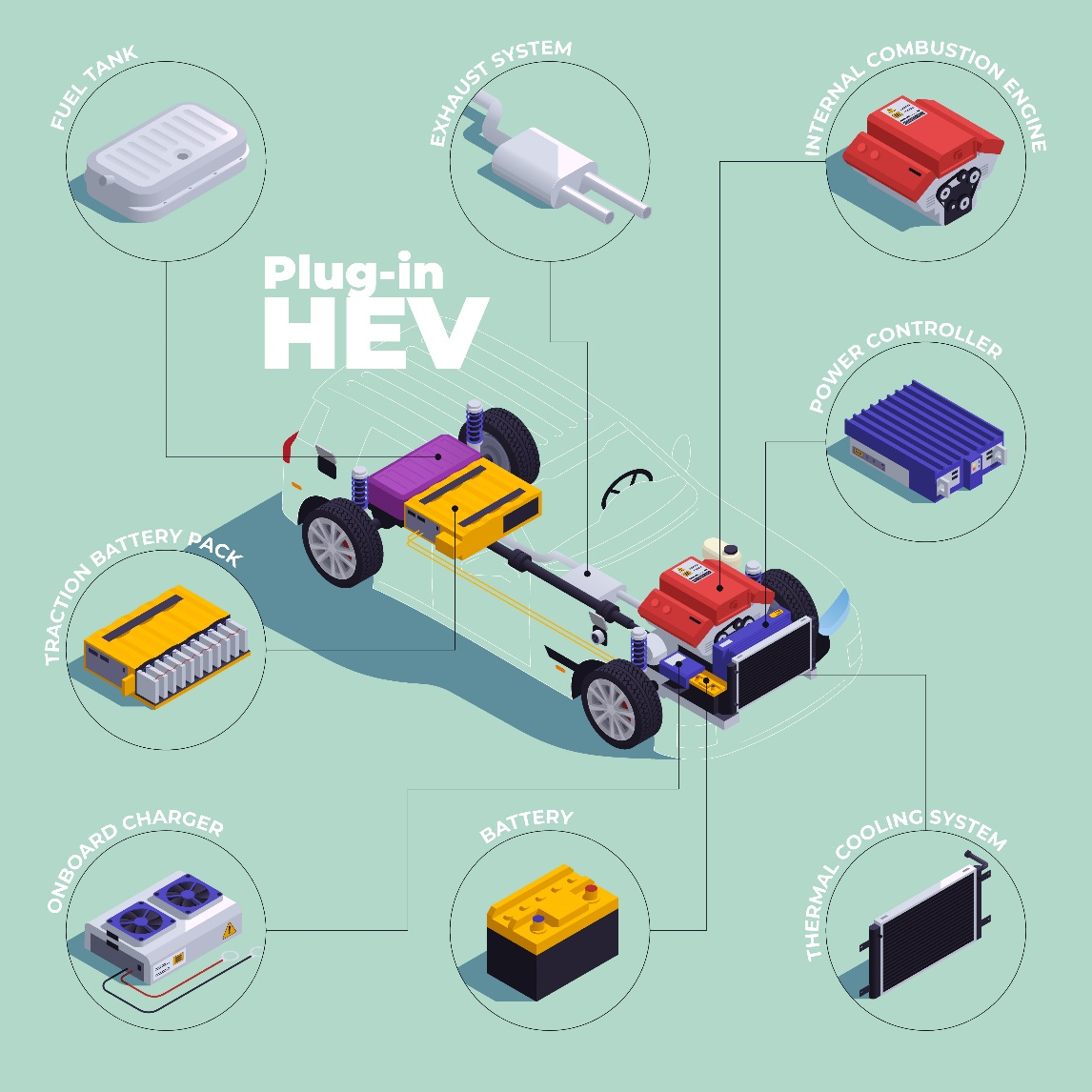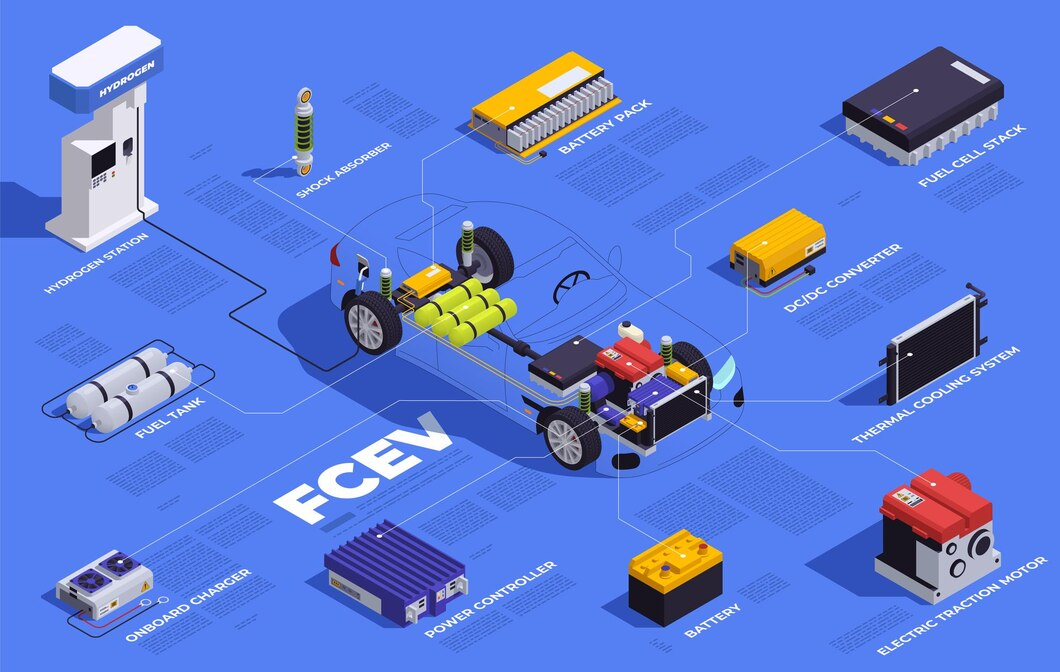Green vehicles
Electric, hybrid, and hydrogen-fuelled cars
Early electric auto vehicles faced limitations in range and charging infrastructure. Battery technology at the time could not sustain a longer use.
The interest in electric vehicles (EVs) in recent decades can be attributed to several factors, including technological advancements (progress in battery technology, cost reductions for other components, increased efficiency), environmental concerns, government policies (subsidies, free charging facilities), and changing consumer preferences.
How do electrical vehicles work?
Battery Electric Vehicles (BEVs) are also known as all-electric. Their engines are solely powered by electricity stored in rechargeable batteries, charged from household outlets (Level 1), dedicated charging stations (Level 2), and fast-charging stations (DC fast charging). Electrical energy is used for propulsion, by the electric motor. BEVs often incorporate regenerative braking systems, which capture kinetic energy during braking and convert it into electrical energy to recharge the battery.

Picture source: Freepik
BEVs have various onboard systems and accessories, powered by the electrical system of the vehicle, which may impact overall energy consumption and driving range.
As battery technology advances continuously and charging infrastructure expands, BEVs are expected to play an increasingly significant role in the transition to sustainable transportation.
How do Hybrid Electric Vehicles work?
Hybrid Electric Vehicles (HEVs) use a combination of an internal combustion engine (ICE) and one or more electric motors to power the vehicle. There are different configurations of HEVs:
- Parallel Hybrid Electric Vehicles: both engines are used directly to drive the wheels. They are more efficient at high speeds
- Series Hybrid Electric Vehicles: the internal combustion engine generates extra electricity for the electrical engine, to drive the wheels. They excel in stop-and-go city drive;
- Plug-in Hybrid Electric Vehicles (PHEVs): combine elements of both parallel and series hybrids, with the added capability of charging the battery pack from an external power source, exactly like an electrical vehicle. They offer the flexibility of electric-only driving with the added range and convenience of an internal combustion engine

Picture source: Freepik
What advantages do electrical vehicles have?
- Environmental benefits: reduction of greenhouse gas emissions, air pollution, and dependence on fossil fuels.
- Economic advantages: lower operating costs, reduced maintenance expenses, and potential long-term savings.
- Performance and driving experience: instant torque, smooth acceleration, and quiet operation.
- Energy efficiency: comparing the efficiency of electric drive to internal combustion engines.
- Technological innovations: integrating smart features, regenerative braking, and vehicle-to-grid capabilities.
Case Studies and Success Stories
- Several European countries have implemented ambitious policies to promote electric vehicle use, which stimulate auto motive industry to produce low-emission vehicles, including electric cars.
- European countries offer purchase subsidies, tax breaks, and free charging to encourage electric vehicle adoption.
- Tesla, headquartered in California, has played a major role in popularizing electric vehicles globally with its successful lineup of electric cars.
How do Hydrogen Vehicles work?
Fuel Cell Electric Vehicles (FCEVs) are a type of electric vehicle that uses hydrogen as a fuel and a fuel cell to generate electricity to power an electric motor.
Hydrogen Fuel is typically produced from natural gas, through a process called steam methane reforming, or from water through electrolysis. It can also be produced using renewable energy sources, such as solar or wind energy, making it a potentially sustainable fuel option.

Picture source: Freepik
A fuel cell converts the chemical energy of hydrogen and oxygen into electricity, with water and heat as byproducts. Hydrogen is typically stored onboard FCEVs in high-pressure tanks or in the form of liquid hydrogen. These storage methods require specialized tanks and insulation to maintain the hydrogen at the required temperature and pressure. The infrastructure for hydrogen refuelling is currently limited but is gradually expanding in regions with a focus on FCEV adoption.
What are the advantages of FCEVs?
- Zero Emissions: FCEVs produce only water vapour and heat as emissions.
- Fast Refueling: refuelling typically takes only a few minutes to fill up the hydrogen tank.
- Long Driving Range: FCEVs offer longer driving ranges compared to battery electric vehicles (BEVs).
What are Challenges and Considerations?
- Hydrogen Production: the production of hydrogen needs an increase in use of renewable energy sources for hydrogen production.
- Infrastructure Development: the infrastructure for hydrogen production, distribution, and refuelling is currently limited compared to other fuel options.
- Cost: FCEVs tend to be more expensive than all other vehicles due to the high cost of hydrogen production and storage. Costs are expected to decrease in time.
What are the biggest challenges of hydrogen powered cars?
It is a very inefficient use of hydrogen, which is expensive to produce and it is rare at the moment. Many other fields of application need hydrogen for decarbonization as you can see in the graph below. Green means "unavoidable use of hydrogen" and red means "uncompetitive use of hydrogen".
What are Challenges and Considerations of all green cars?
Green cars are not without issues:
- they are expensive to buy
- they take a considerable time to recharge
- they may generate no tailpipe emissions but the battery power sources, the recycling of its components, and the manufacture of the vehicles and batteries contribute to carbon emissions
- mining of many of the raw materials raises both ethical and environmental issues
- electric cars are still individualized motorized mobility, which means congestions and road casualaties
But the lack of a hydrogen refueling infrastructure, the challenges around transporting the fuel and the fact that you need a lot more energy to make a hydrogen vehicle move than a battery electric vehicle means for now, the future is battery electric. Moreover, electric busses are common in many cities, and the future will bring the electric lorries.
